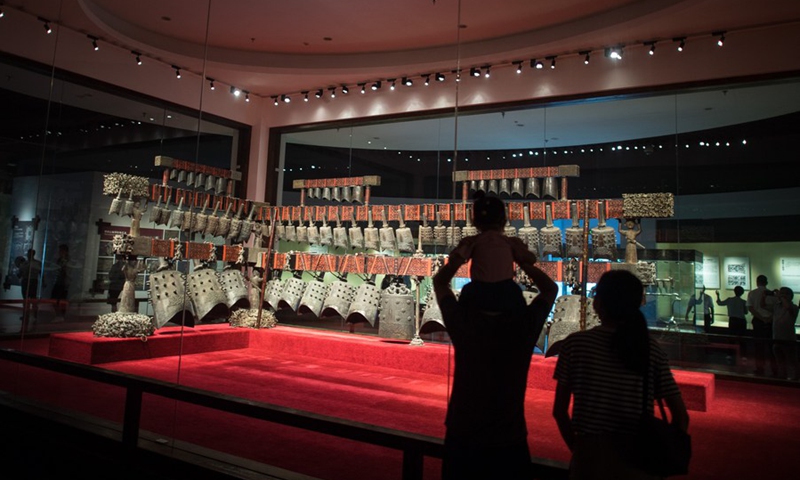Chinese bronze relics repatriated from Japan go on display at Hubei Provincial Museum
By Chen Xi Source: Global Times Published: 2020/9/14 22:12:10 Last Updated: 2020/9/14 14:15:10

Visitors view exhibits at the Hubei Provincial Museum in Wuhan, capital of central China's Hubei Province, June 14, 2020. (Xinhua/Xiao Yijiu)
An exhibition displaying a batch of exquisite ancient Chinese relics at the Hubei Provincial Museum in Wuhan, Central China's Hubei Province, has attracted thousands of visitors from across China, demonstrating Chinese people's confidence in the city's improved COVID-19 situation, a museum employee said on Monday.
The exhibition From Oblivion to Glory - Treasures from the Noble Family of Zeng opened to the public on Saturday. The exhibition, which also includes a set of ancient bronze relics repatriated from Japan, displays an exquisitely curated collection of elegant cultural relics unearthed from the Zeng State over the past 10 years.
The Zeng State was one of the vassal states under the leadership of the Western Zhou Dynasty (1046BC-771BC) kings. In 1987, the discovery of an ancient tomb in Suizhou city, Hubei Province, revealed a larger burial ground for leaders of the Zeng State.
The exhibition is the first large-scale display of cultural relics unearthed at the Zeng State site, fully presenting the bronze culture of the Zeng State from the early Western Zhou Dynasty (1046BC-771BBC) to the middle Warring States Period (475BC- 221BC), said Liu Yuzhu, head of China's National Cultural Heritage Administration (NCHA), in a statement on the NCHA's official WeChat account.
The exhibition is the first large-scale cultural relic exhibition the museum has held since it reopened on June 14, according to Liu.
Some of the most eye-catching relics are a set of Chinese bronzes that had been smuggled overseas and later retrieved from Japan in 2019. After the relics' return, authorities and experts conducted a series of comprehensive evaluations and determined them to be national-level artifacts dating back to the early Spring and Autumn Period (770BC-476BC).
The eight-piece bronze ware set was displayed at the National Museum of China on September 17, 2019 to mark the 70th anniversary of the founding of the People's Republic of China. They have now been transferred to the Hubei Provincial Museum to help revitalize the province's economy and tourism industry in the wake of the COVID-19 epidemic.
An employee working at the Hubei Provincial Museum who asked to remain anonymous told the Global Times on Monday that visitors showed great excitement while viewing the exhibition.
For safety reasons, the museum has implemented a series of strict measures for epidemic control and prevention. Tourists need to book tickets online, show their ID card and a green health QR code at the entrance, and pass a temperature check. Those who do not have an ID card from the Chinese mainland also need to show nucleic acid test results, according to the employee. Additionally, while on museum grounds all visitors must wear face masks.
She added that the museum has raised its daily cap on single person visits from 1,000 to 3,000, while the group tour limit sits at 200. Group tours, which may not have more than 30 people, must wait 30 minutes between visits.
She noted that visitors appeared very at ease while at the museum, since the epidemic situation in China has improved greatly.
Posted in: ART,CULTURE & LEISURE